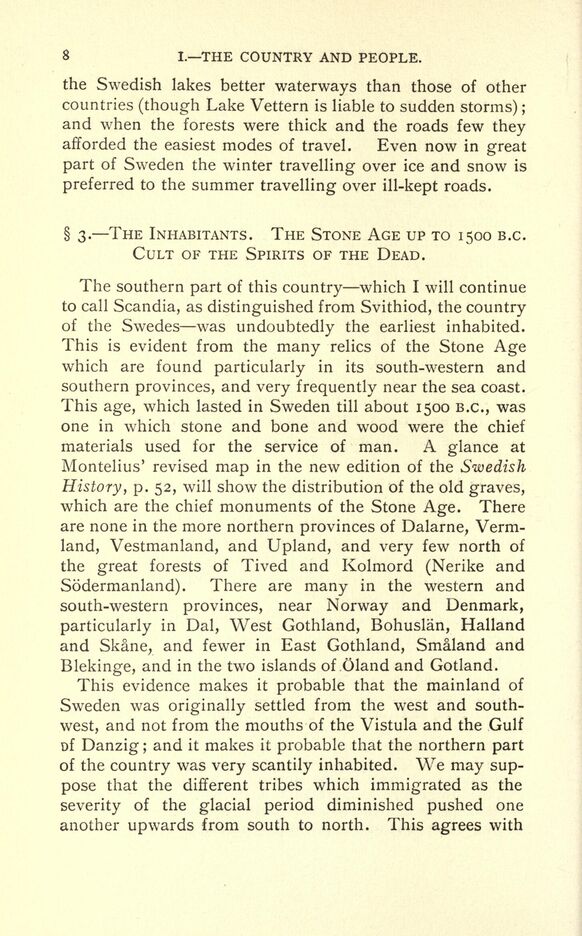
Full resolution (JPEG) - On this page / på denna sida - I. Introductory Lecture.—The Country and its Inhabitants in the Heathen Period up to 1000 A.D. - § 2. Natural Features of the Country - § 3. The Inhabitants—The Stone Age

<< prev. page << föreg. sida << >> nästa sida >> next page >>
Below is the raw OCR text
from the above scanned image.
Do you see an error? Proofread the page now!
Här nedan syns maskintolkade texten från faksimilbilden ovan.
Ser du något fel? Korrekturläs sidan nu!
This page has never been proofread. / Denna sida har aldrig korrekturlästs.
I. THE COUNTRY AND PEOPLE.
the Swedish lakes better waterways than those of other
countries (though Lake Vettern is liable to sudden storms) ;
and when the forests were thick and the roads few they
afforded the easiest modes of travel. Even now in great
part of Sweden the winter travelling over ice and snow is
preferred to the summer travelling over ill-kept roads.
3. THE INHABITANTS. THE STONE AGE UP TO 1500 B.C.
CULT OF THE SPIRITS OF THE DEAD.
The southern part of this country which I will continue
to call Scandia, as distinguished from Svithiod, the country
of the Swedes was undoubtedly the earliest inhabited.
This is evident from the many relics of the Stone Age
which are found particularly in its south-western and
southern provinces, and very frequently near the sea coast.
This age, which lasted in Sweden till about 1500 B.C., was
one in which stone and bone and wood were the chief
materials used for the service of man. A glance at
Montelius revised map in the new edition of the Swedish
History, p. 52, will show the distribution of the old graves,
which are the chief monuments of the Stone Age. There
are none in the more northern provinces of Dalarne, Verm-
land, Vestmanland, and Upland, and very few north of
the great forests of Tived and Kolmord (Nerike and
Sodermanland). There are many in the western and
south-western provinces, near Norway and Denmark,
particularly in Dal, West Gothland, Bohuslan, Halland
and Skane, and fewer in East Gothland, Smaland and
Blekinge, and in the two islands of .Gland and Gotland.
This evidence makes it probable that the mainland of
Sweden was originally settled from the west and south
west, and not from the mouths of the Vistula and the Gulf
of Danzig ;
and it makes it probable that the northern part
of the country was very scantily inhabited. We may sup
pose that the different tribes which immigrated as the
severity of the glacial period diminished pushed one
another upwards from south to north. This agrees with
<< prev. page << föreg. sida << >> nästa sida >> next page >>